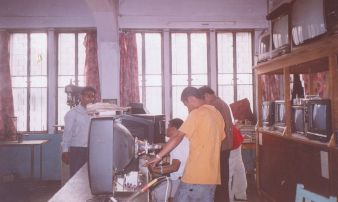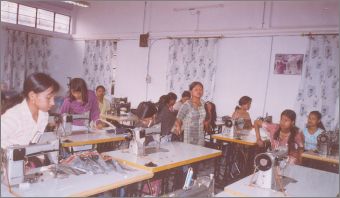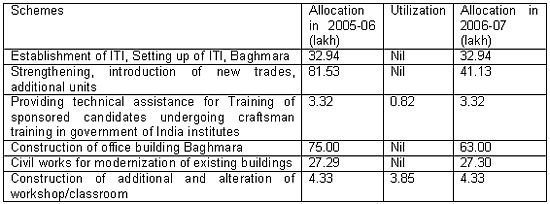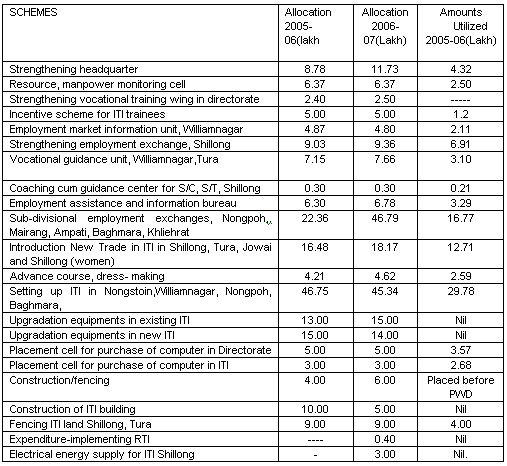In December 2001, Shyam Century Ferro Alloys Limited, an industrial unit of ferrous products at Byrnihat industrial area in Ri-Bhoi district of Meghalaya, 80 kms off from the capital city Shillong was getting ready for commissioning. The Personnel Manager of the company, Gautom Bora, began scouting for local youth trained at the Industrial Training Institutes (ITI) of the state, for absorption in the industrial unit as fitters, electricians and mechanics.

![]() Trainees at Don Bosco Technical School, Shillong learining television repairing. Pic: Ratna Talukdar.
Trainees at Don Bosco Technical School, Shillong learining television repairing. Pic: Ratna Talukdar.
As the search yielded no result, Bora had no option but to conduct campus interviews in ITIs of neighbouring Assam and recruited some trained youth from there, as the commissioning date of the industry was drawing near. Today, even after six years of the commissioning, Bora feels that recruitment of local ITI graduates is more beneficial and viable for the industry. But Byrnihat still does not have an ITI to cater to the requirements of Shyam Century Ferro Alloys or many such industrial units that have come up over the recent years.
Byrnihat was developed as an Export Promotion Industrial Park (EPIP) by the state government under a centrally sponsored scheme for rapid industrial growth as well as creating employment opportunities for local people. About 35 industrial units of different products have come up till now. There are ample opportunities for the local ITI passouts in these units as well as in the downstream business ventures. But almost all the posts of fitters, welders, mechanics, electricians etc. and others have been filled up by the passouts from Assam.
A training deficit starting with the top
Since then, around 6,000 institutions at plus two stage of education have introduced under the programme. Around 150 educational courses are being offered with an intake capacity of 10 lakh students per year.
This largest single vocational education and training programme is followed by the Industrial Training Institutes and Polytechnics in the country. The programme covers all major career areas including agriculture, engineering and technology, business and commerce, home science, health and paramedical, humanities, science and education.

•
Training millions left behind
•
All theory and no practice
Even after four decades of Kothari Commission's recommendations, Meghalaya has only 10 ITIs with a total seat capacity of 912 for imparting vocational training eight run by Meghalaya government and two private. Apart from these, there is a centrally sponsored Regional Vocational Training Institute for Women (RVTI) located in Tura in West Garo Hills district. This is against 534 such institutions in Tamil Nadu, 622 in Maharastra, 469 in Kerala, 560 in Andhra Pradesh, and 248 in Uttar Pradesh. By comparison, there are only 53 government ITIs in the eight northeastern states including that in Meghalaya with a total seat capacity of 7244. Assam has 27, Arunachal Pradesh-2, Manipur-6, Mizoram-1, Nagaland-4, Tripura-4 and Sikkim-1.
In Meghalaya, of the two private run vocational training institutes, the Don Bosco Training School (DBTS), a major institute in the state, imparts 11 vocational courses. The Anderson Institute of Computer education, in Dhankheti in Shillong, is another private ITI. But it does not have a comprehensive curriculum, and imparts training only on computer education.
Courses in Meghalaya's ITIs include electrician, motor vehicle mechanic, wireman, machinist, fitter, turner, welder, carpentry, cutting and tailoring, letter press minder, book-binding, hand compositor, radio and television mechanic, desk top publishing operator, computer programme assistance, plumber, stenography, dress making, advance dress making, hair and skin care, toymaking, typing and surveyor and architectural draughtsman.
Reality check
Meghalaya's vocational training system has two problems currently. One, there is dearth of adequate number of ITIs in Meghalaya to produce a skilled workforce. Two, their placement record has remained less than 50 per cent.
Overall placement -- government institutions, 1994-1997: 49%

ITIs at Rynjah, Shillong, 2001-2006: (39%)

Don Bosco Technical School, Shillong, 2002-2005): very low

Commenting on underemployment of ITI trainees in the state, Director, Employment and Craftsman Training, Meghalaya, K Larteng says that the coming up of multinational companies with latest technology expertise in the private sector, as well as abolishment of jobs in public sector have made tremendous negative impact on recruitment of ITI pass outs in recent years. "Ongoing ITI courses in Meghalaya were designed for older industries in organised sectors. These curricula hardly meet the requirement and skill needed for the present day industries with high technological expertise," says Larteng.
"Firstly, ITI trainees from the institutions of Meghalaya are considered as under-skilled in the new industrial units which use the most sophisticated technology. Secondly, the salary structure of these units is not up to the expectation level of the ITI pass outs," adds Larteng.
Bora, however feels that because of lack of exposure of the ITI students to existing industrial units of Meghalaya and also in other states, the ITI trainees have not been able to visualise their employment potential. Visiting different industrial units during the time of training in ITIs at the initiative of ITI heads, may help in getting an idea about the requirement of the industries and formulating the course curriculum and also motivating the trainees to approach these industries for placement at the completion of the courses, says Bora. "Unfortunately, during my six years tenure in this industry, no ITI head has ever paid a visit in this area along with trainees," he says.
According to Bora, a skilled and experienced fitter trained in an ITI institution can earn up to Rs.30000 per month or even more depending on individual skill and aptitude.
Between 2001 and 2006, the Directorate of Employment and Craftsmen Training, Meghalaya sent 82 trainees to advanced institutions elsewhere the country at Hissar, Hyderabad, Dehradun, Calicut, Ludhiana, Noida, Jaipur, and some other locations. This was under a centrally sponsored scheme for training in preservation of fruits and vegetables, medical electronics, electronics and electrical, tools and die-maker, sheetmetal works, refrigerator and air-conditioning, architectural draughtsman, industrial electronics. Almost 90 per cent of them have returned to Meghalaya and of them about nine have found employment in the state, says Garod LSN Dykes, Deputy Director.

![]() Trainees at the government-run ITI for Women at Ryanjah in Shillong, learning soft toy making.
Pic: Ratna Talukdar.
Trainees at the government-run ITI for Women at Ryanjah in Shillong, learning soft toy making.
Pic: Ratna Talukdar.
While advanced courses are yet to be introduced in government-run ITIs in Meghalaya, the DBTS, the pioneering private institute of vocational training, too, has no such training in its courses either. Also, the DBTS in other states provide extensive vocational training for sustainable development including agro-based machinery, bakery, smokeless chullas, vermi-composting, food processing, agro-based training, horticulture, organic paste control and others.
Responding to a question why the institution has not introduced such courses in Meghalaya, Father Alex Benny, principal of the institute says that in Meghalaya, the DBTS follow the courses designed by National Council of Vocational Training, under the Ministry of Labour, as it was affiliated to the Council. The curriculum approach could not be more misplaced. Meghalaya has a strong tradition of producing horticulture products including ginger, cashew nut, oranges, pineapple and floriculture, which have been regularly exported to countries like United Kingdom, Bangladesh etc.
No death of training funds, but under utilised
The rot in training direction and management goes all the way into planning and funds utilisation. During the year 2005-06 in Meghalaya only Rs.4.67 lakh against an allocation of Rs.2.24 crore provided under centrally sponsored schemes has been utilised. The details:
Central funds utilisation

In the same year, Meghalaya's utilisation of its own fund was also only Rs 95.79 lakh against Rs 2.05 crore, allocated under various schemes for development of ITIs in the state. The details:
State funds utilisation

Asked about the reason behind the substantive under utilisation of funds, Deputy Director Dykes said that the allocated funds also include the salary component of the employees. Since a number of posts are lying vacant, the salary component against these vacant posts could not be utilised. He further said that that supply of equipments to various ITI units had not proceeded, which has also contributed to poor utilisation of allocated funds. In the meantime, an amount of Rs.89.40 lakh has been allocated for vocational training institutes for the year 2007-08.
Meghalaya's laxity in pushing forward in utilising funds has not gone unnoticed. According to a brief for the meeting of High Level Group, North Eastern Region Cell of Ministry of Human Resource Development held at Guwahati on 29 May 2005, no grant was released for implementation of the scheme of Vocationalisation of Secondary Education during the 9th and 10th Five Year Plan period in Meghalaya.
Although total grant of Rs.39.05 lakh had been released prior to this period, members of the cell had identified that Meghalaya government did not submit detailed progress report. It had also identified that progress of implementations of the schemes as "very poor". Further, the cell had not received any "expansion proposal" till that time, according to the brief.
The only saving consolation, if at all, for the state is that the challenges are nationwide. During the 10th Five Year Plan, there was an allocation of Rs.350 crores to introduce vocational courses and streams at the 10+2 stage throughout the country. Of this, only Rs.61 crores was utilised.
Indigenising training inputs - Women in matriarchal Meghalaya
In its report, the Working Group on Secondary and Higher Education for the 11th Five Year Plan (2007-2012) underlined the importance of Vocational Education and Training (VET) by stating that VET "should be provided to those who need skills for sustainable livelihood and to meet the challenges of the world of work. The concept of VET to all should be promoted through the formal education system and non-formal education system. It should cater the needs of different target groups, with special provisions for disadvantageous groups viz, girls, women, scheduled castes, scheduled tribes, persons with disabilities and persons living in difficult circumstances."
The working group has also said that strategies for encouraging access to VET for marginalised groups, including SCs, STs, OBCs, minorities, girls, street children, working children and differently-abled children, should be adopted.
Meghalaya's three major tribes Khasis, Jaintias and Garos follow matriarchy. Women's participation in trade and commerce in their traditional society is marginally higher. Despite this, vocational education courses are yet to be designed tapping into the traditional strengths and skills of the indigenous women of the state. Director Lartang, as well as institutional heads of several institutions, acknowledge this.
The Byrnihat area itself, where we began this story, is populated by two tribes, the Garos and the Karbis. Women of both these communities have a dominating role in traditional trade and commerce. However, in absence of any skill development training, the local women have been engaged mostly as unskilled workers in local industries like Kakarania Innovative Systems, Shyam Century Ferro Alloys Limited and others, where they earn Rs.60 to Rs.70 a day.
The ITI for Women located in Rynjah in Shillong has four courses in its curriculum dress-making, advance dress making, hair and skin care and toymaking. The toymaking course started the first batch in April 2007. Principal Arup Nath, says that while the present market demands introduction of courses like advance dress-designing and fashion technology through computers, the institute still offers out-dated and irrelevant courses, which do not have any demand even in the village markets. "Further, lack of production units to engage the trainees at least for some years to achieve necessary skill is a major problem for us," says Nath. Lack of infrastructure, skilled manpower and absence of funding agencies have come in the way of starting a production unit inside the ITI campus, adds Nath.
At the Rynjah ITI, a soft toymaking unit has been set up at the initiative of Department Development of North East, this year with a grant of Rs.50 lakhs. Altogether 100 trainees in four batches have undergone the training programme. The Institute of Toy Making Technology (ITMT) Calcutta, under the guidance of which the training programme is being imparted, would make arrangements for marketing of soft toys made in this institute, says Keya Benarji, instructor of the unit.
Replying to a question on whether the institution has considered the idea of making toys with a local traditional touch instead of adopting those of the style and look that have already flooded the market, Benarji says that what they have done were entirely under the guidance of ITMT, Calcutta, which had a definite format of toymaking and they were bound to follow that.
The centrally sponsored Regional Women Vocational Training Institute, situated in Tura in West Garo Hills district, established in 1986, is one of 11 such institutes established under the Directorate General of Employment and Trainings, Ministry of Labour. The institute provides regular courses on electronics, instrument mechanic, computer operator and programme assistant, desktop publishing operator, dress-making, secretarial practices and hair and skin care, according to T S Verma, the principal of the institute. The institute, that runs full time as well as short time courses, has a hostel in its campus and imparts training for women of entire northeastern region. Each unit has a seat capacity of 16 trainees.
Asked about the placement position, Verma says, "West Garo Hills district is extremely remote with no industries for absorbing the pass outs. We have started a placement cell in 2006, but employment opportunities for such trainings are very limited." But this institute, too, is yet to consider the issue of providing innovative skill development trainings on the basis of traditional skills of tribal women in northeastern region as a whole and Meghalaya in particular, for locally employment and engagement of the pass outs, the principal admits. Passouts may avail bank loans at their own initiative may run small business units if they wish, he says. Only a few of them get absorbed in government jobs, according to him.
For its part, private leader DBTS too has not a designed a course in its syllabus of vocational education in enhancing traditional skills of tribal women of this India's only matriarchal state. However, few girls have taken admission in courses including computer education, driving, mechanics etc, says Father Benny.
"There must be a policy push at the government for revision and modernisation of courses included in vocational training so that pass outs avail placement in the changing environment of trade and industry. Courses, aiming at both aspects of technological advancement in industrial sector, as well as enhancing indigenous skills of tribal people in the state will help generating employment of youths", says Dykes, Deputy Director at the Directorate of Employment and Craftsmen Training.
As Meghalaya stumbles along, a few things are clear. Despite availability of funds, the principals, directors of training and others have not been able to push forward. There is a lack of policy initiative on the part of the state government to link the vocational education and training with industrialisation and other employment avenues. In absence of attractive placement of the ITI trainees, the demand for more ITIs or revised curriculum is yet to take shape among the students which otherwise could have influenced the Meghalaya government's policy further.























